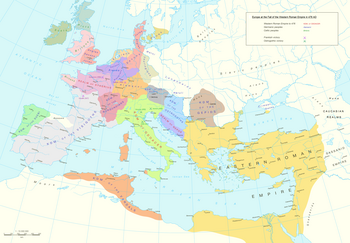
The Burgundians were an early Germanic tribe or group of tribes. They appeared in the middle Rhine region, near the Roman Empire, and were later moved into the empire, in eastern Gaul. They were possibly mentioned much earlier in the time of the Roman Empire as living in part of the region of Germania that is now part of Poland.
The 450s decade ran from January 1, 450, to December 31, 459.

Year 411 (CDXI) was a common year starting on Sunday of the Julian calendar. At the time, it was known as the Year of the Consulship of Theodosius without colleague. The denomination 411 for this year has been used since the early medieval period, when the Anno Domini calendar era became the prevalent method in Europe for naming years.

Clovis was the first king of the Franks to unite all of the Frankish tribes under one ruler, changing the form of leadership from a group of petty kings to rule by a single king and ensuring that the kingship was passed down to his heirs. He is considered to have been the founder of the Merovingian dynasty, which ruled the Frankish kingdom for the next two centuries. Clovis is important in the historiography of France as "the first king of what would become France".

Clotilde, also known as Clothilde, Clotilda, Clotild, Rotilde etc., was a Queen of the Franks. She was supposedly descended from the Gothic king Athanaric and became the second wife of the Frankish king Clovis I in 493. The Merovingian dynasty to which her husband belonged ruled Frankish kingdoms for over 200 years (450–758).

Gundobad was King of the Burgundians (473–516), succeeding his father Gundioc of Burgundy. Previous to this, he had been a patrician of the moribund Western Roman Empire in 472–473, three years before its collapse, succeeding his uncle Ricimer. He is perhaps best known today as the probable issuer of the Lex Burgundionum legal codes, which synthesized Roman law with ancient Germanic customs. He was the husband of Caretene.

The Kingdom of the Franks, also known as the Frankish Kingdom, the Frankish Empire or Francia, was the largest post-Roman barbarian kingdom in Western Europe. It was ruled by the Frankish Merovingian and Carolingian dynasties during the Early Middle Ages. Francia was among the last surviving Germanic kingdoms from the Migration Period era.

Sigismund was King of the Burgundians from 516 until his death. He was the son of king Gundobad and Caretene. He succeeded his father in 516. Sigismund and his brother Godomar were defeated in battle by Clovis's sons, and Godomar fled. Sigismund was captured by Chlodomer, King of Orléans, where he was kept as a prisoner. Later he, his wife and his children were executed. Godomar then rallied the Burgundian army and won back his kingdom.
Kingdom of Burgundy was a name given to various states located in Western Europe during the Middle Ages. The historical Burgundy correlates with the border area of France and Switzerland and includes the major modern cities of Geneva and Lyon.
Godomar II, son of king Gundobad, was king of Burgundy. He ruled Burgundy after the death of Sigismund, his elder brother, in 524 until 534.
Gondioc, also called Gunderic and Gundowech, was a King of the Burgundians, succeeding his putative father Gunther in 436.
Godegisel was a Burgundian sub-king and son of the Burgundian king Gondioc.
Chilperic II was the King of Burgundy from 473 until his death. Before that he co-ruled with his father Gondioc beginning in 463. He began his reign in 473 after the partition of Burgundy with his younger brothers Godegisel, Gundobad, and Godomar; he ruled from Valentia Julia (Valence) and his brothers ruled respectively from Geneva, Vienne, and Lyon.

The Lex Burgundionum refers to the law code of the Burgundians, probably issued by king Gundobad. It is influenced by Roman law and deals with domestic laws concerning marriage and inheritance as well as regulating weregild and other penalties. Interaction between Burgundians is treated separately from interaction between Burgundians and Gallo-Romans. The oldest of the 14 surviving manuscripts of the text dates to the 9th century, but the code's institution is ascribed to king Gundobad, with a possible revision by his successor Sigismund. The Lex Romana Burgundionum is a separate code, containing various laws taken from Roman sources, probably intended to apply to the Burgundians' Gallo-Roman subjects. The oldest copy of this text dates to the 7th century.
Gundomar I was eldest son and successor of Gebicca, King of the Burgundians. He succeeded his father in 406 or 407 and reigned until 411. He was succeeded by his brother Giselher.
Godomar I was a son of the Burgundian king Gondioc, and a brother of Godegisel, Chilperic II and Gundobad. After the death of Gondioc and his brother Chilperic I, the four sons of Gondioc are said to have ruled Burgundy together from different parts of the kingdom. This is doubted by modern scholars due to lack of evidence. It is now believed that both Godomar and Chilperic had died before 476/477, and that only Godegisel and Gundobad shared the rule.

The Franco-Visigothic Wars were a series of wars between the Franks and the Visigoths, but it also involved the Burgundians, the Ostrogoths and the Romans. The most noteworthy war of the conflict would be the Second Franco-Visigothic War that included the famous Battle of Vouillé and resulted in Frankish annexation of most of Southern France.
Teudelinda was a Burgundian queen consort by marriage to king Godegisel. She founded a number of churches around Geneva. Teudelinda was killed at Vienne during the war between her husband and his brother, Gundobad.

The Burgundian Revolt of Gunther consisted two revolts of the Burgundian foederati in the Western Roman Empire during the reign of Emperor Valentinian III. The uprisings happened in the Gallic province of Germania Prima and was led by the King of the Burgundian Gunther, his main opponent was General Aetius.










